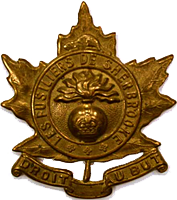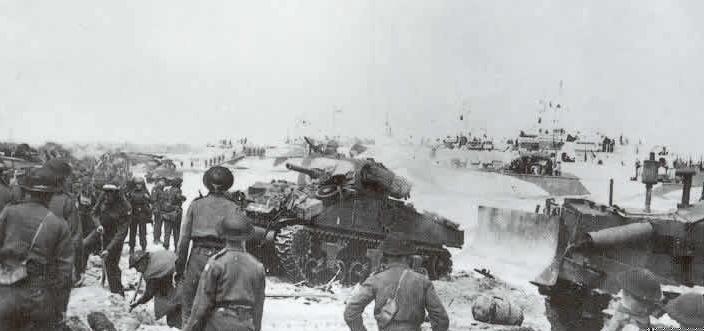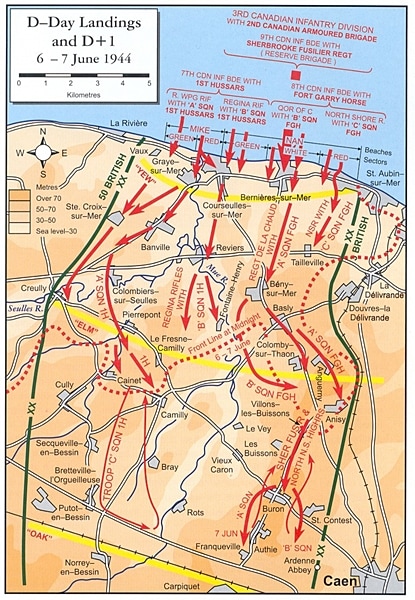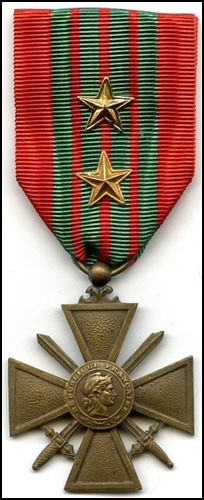About the Author
| Capt. N.M. McDougall, of the Elgin Regiment, transferred to Brigade Headquarters and, for the D-Day operation, served as a tank unit landing officer with the 2nd Canadian Armoured Brigade. His job was to reconnoiter areas for tank operations. In 1945, the President of the Provisional French Government, General Charles DeGaulle, presented McDougall with the Croix de Guerre avec Etoile de Vermeil for his actions during the D-Day landing. |
H-Hour
The rocket ships provided the most spectacular sights. The rockets went off in groups of ten or so, with only seconds between groups. It was a fiery show as hundreds of rockets were shot from the banks of pipes on the decks of the rocket ships.
The Sherbrooke Fusiliers
| The Sherbrooke Fusiliers were in reserve and started to land on Nan sector of Juno Beach about 3 ½ hours after the initial assault troops. The LCT crew had just lowered a ramp on our run into the beach when we struck a mine. It blew off the left side of the ramp and we were concerned that the supports on the right side would not hold the weight of the tank. The naval lieutenant told us not to worry. He said he would put us in shallow water, which he did. The ramp held as the first tank went off and the LCT was quickly emptied. |
Secured the Beach Area
In Under Three Hours
Bodies were Everywhere
Engineers had been among the first to land. They used armoured bulldozers and flails to clear roads through the minefield. The flails were tanks with a revolving drum in front two which chains were attached. The chains beat the ground and set off any mines.
Bernieres sur Mer
At the railway station, our troops were rounding up prisoners. On the far edge of the village the advance was stopped because of Germans shooting anything that tried to go out of the village. Shells landed intermittently around Bernieres. There were still German soldiers in some of the houses and in the church tower. Traffic began to back up in Bernieres. Efforts were made at dispersal but more and more vehicles kept coming from the beach. The village became jammed with vehicles and troops. Finally, the guns stopping the advance were silenced and soon tanks with infantrymen on their backs left Bernieres. One of the surprises of D-Day was the absence of German planes. Allied air forces gave such good protection that the only visible aircraft were spitfires and Lightnings patrolling above the landing sites. It was different after dark however.
Back at the Beach - A Change of Plan
Moving Inland
| When darkness came, the Brigadier said he wanted to find the armoured units and meet with the regimental commanders. We set out not knowing where the enemy was and with only a general idea of where our own troops were located. We had gone inland quite a long time without seeing anybody, not even any sign of our troops. We turned down the next crossroad and soon came upon tanks. It was one of our columns. Everyone was preparing for the expected German counter-attack. Later, some planes came over but it was not until the night after D-Day that the Germans made a major bombing attack on the bridgehead. A lot had happened but there would soon be another day to face. We tried to get some sleep in a French farmyard. |
Citation Awarded to Captain Neil Mansfield McDougall
Croix de Guerre avec Etoile de Vermeil
| Captain McDougall has been on active service since August 1940, enlisting with the Elgin Regiment. He went overseas with the advance party in 1942 and later served with brigade headquarters, going to France on D-Day in the latter position. It was for his accomplishments on that day that this award has been made and the following citation has been given: Landed at Noon “At approximately noon on D-Day, Capt. McDougall who was acting as tank unit landing officer for brigade headquarters landed with 27 Canadian Armored Regiment on the beach opposite Bernieres-sur-Mer. “He immediately moved inland to reconnoitre a pre-selected area well forward where brigade headquarters was to be established. He then returned to the beach to arrange for the detailed landing of brigade vehicles. On finding that these would not be landed for some time, he again proceeded inland and gave invaluable assistance in controlling and directing traffic which was often done while exposed to enemy fire. “None of brigade headquarters vehicles landed until that night and most of them not until late on D plus 1. Consequently Capt. McDougall and his jeep, which was equipped with a wireless set, were used extensively by the brigade commander. Under the most difficult conditions, in which enemy sniping played a prominent part, he successfully maintained communications with both brigade headquarters afloat and the regiments taking part in the battle. This was of the most vital importance insofar as it was the only means of control that could be exercised from brigade during that period. “He subsequently resumed his normal duties which included the reconnaissance of a number of positions. This required him to proceed into the forward area where he was exposed to heavy enemy fire. “He performed his multitudinous tasks most efficiently and without regard for his personnel well-being. The cheerful manner in which he has accomplished his work and the thoroughness and excellence thereof, have been an example of the finest spirit and has fostered a high sense of duty in all those who have been associated with him in this operation.” Captain Neil Mansfield McDougall of St. Thomas, Ontario was awarded the Croix de Guerre by Charles de Gaulle, President of the Provisional Government of the Republic of France on the 3 April 1945 for his actions on D-Day. |





 RSS Feed
RSS Feed